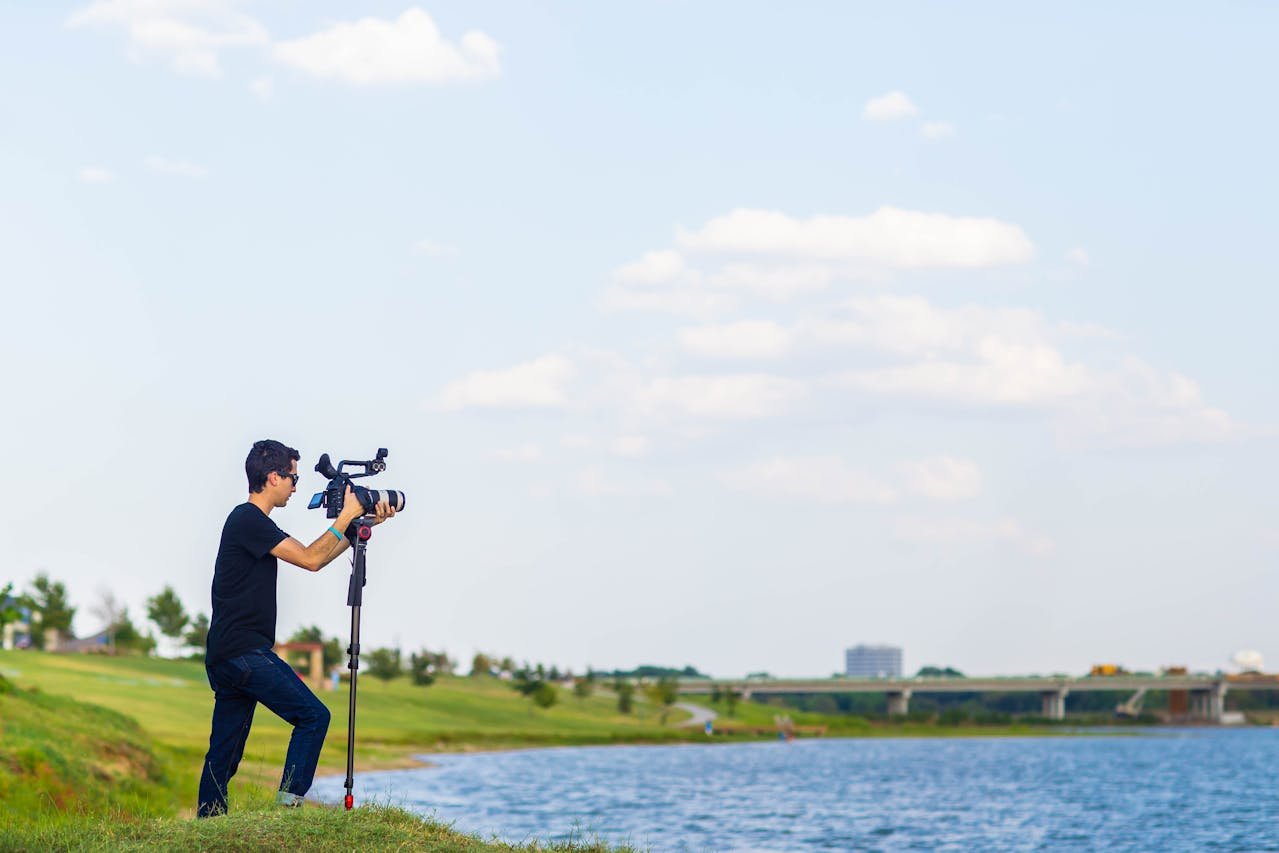In today’s visual world, photography plays a crucial role in marketing. High-quality images can capture attention, convey messages, and build emotional connections with your audience. Whether you’re promoting products, services, or your brand, the right photographs can significantly enhance your marketing efforts. We’ll explore practical and creative ways to use photography to boost your marketing strategy.
Understanding the Importance of Photography in Marketing
Creating a Visual Impact
Photography helps create a strong visual impact that can grab attention instantly. People are naturally drawn to images, and a well-captured photograph can convey a message more effectively than words alone.
High-quality images can make your marketing materials more engaging and memorable.
Building Brand Identity
Consistent and professional photography helps build a strong brand identity. By using a cohesive style and theme in your photos, you can create a recognizable brand image that resonates with your audience.
This consistency helps establish trust and loyalty among your customers.
Evoking Emotions
Photographs have the power to evoke emotions, which can influence consumer behavior. By using images that resonate with your audience’s feelings and experiences, you can create a deeper connection with them.
This emotional engagement can lead to higher conversion rates and customer retention.
Choosing the Right Photography for Your Marketing
Product Photography
For businesses selling products, high-quality product photography is essential. Clear, detailed, and attractive images can highlight the features and benefits of your products, making them more appealing to potential customers.
Consider using multiple angles and close-ups to provide a comprehensive view of your products.
Lifestyle Photography
Lifestyle photography showcases your products or services in real-life situations. This type of photography helps potential customers visualize how they can use your offerings in their daily lives.
It adds context and relatability, making your marketing more effective.
Branding Photography
Branding photography focuses on capturing the essence of your brand. These images represent your company’s values, culture, and personality.
They can include pictures of your team, office space, or events. Using branding photography consistently across your marketing channels helps create a strong, cohesive brand image.
Event Photography
If your business hosts events, event photography can be a powerful marketing tool. Capturing moments from your events can showcase your company’s community involvement, highlight key moments, and provide content for future promotions.
These images can also be shared on social media to increase engagement and reach.
Integrating Photography into Your Marketing Strategy
Website and Blog
Your website and blog are prime places to showcase high-quality photography. Use engaging images to complement your content, illustrate points, and break up text.
This makes your website more visually appealing and can keep visitors on your site longer.
Social Media
Social media platforms are highly visual, making photography an essential component of your social media strategy. Share compelling images that reflect your brand and engage your audience.
Use a mix of product photos, lifestyle shots, and behind-the-scenes images to keep your content diverse and interesting.
Email Marketing
Incorporating photography into your email marketing can significantly increase engagement. Use images to highlight products, announce events, or share company news.
Make sure your photos are optimized for email to ensure they load quickly and look great on all devices.
Advertising Campaigns
High-quality photography can elevate your advertising campaigns. Whether you’re running ads on social media, search engines, or print media, striking images can capture attention and convey your message effectively.
Invest in professional photography to ensure your ads stand out from the competition.
Best Practices for Using Photography in Marketing
Hire a Professional Photographer
While smartphone cameras have improved, hiring a professional photographer can make a significant difference in the quality of your images. Professionals have the skills, equipment, and experience to capture high-quality photos that align with your brand.
Use Consistent Editing
Consistency in editing helps maintain a cohesive look across all your marketing materials. Use the same filters, color schemes, and editing techniques for all your photos.
This creates a unified brand image that is easily recognizable.
Optimize Images for Different Platforms
Different marketing platforms have varying requirements for image size and format. Ensure your photos are optimized for each platform to maintain quality and improve loading times.
This is especially important for your website and email campaigns, where large images can slow down performance.
Tell a Story
Use photography to tell a story that resonates with your audience. Whether it’s the story of your brand, a product’s journey, or a customer’s experience, storytelling through images can create a deeper connection with your audience.
Plan your photoshoots with a narrative in mind to make your images more impactful.
Advanced Techniques for Using Photography in Marketing
Creating a Visual Content Calendar
Planning Your Photography Schedule
Develop a visual content calendar to organize and plan your photography needs. Outline the themes, campaigns, and key dates for your marketing efforts.
Schedule photoshoots well in advance to ensure you have high-quality images ready for each campaign. This proactive approach helps maintain a steady flow of fresh content and avoids last-minute scrambles for images.
Coordinating with Marketing Campaigns
Align your photography schedule with your overall marketing campaigns. Ensure that each photoshoot produces images that can be used across multiple channels, such as social media, email marketing, blog posts, and advertisements.
This coordination ensures consistency in your branding and maximizes the use of each photo.
Utilizing Photography for Different Marketing Channels
Social Media Platforms
Each social media platform has its own requirements and best practices for photography. For Instagram, focus on visually striking images with a cohesive aesthetic.
Facebook allows for a mix of lifestyle shots, product photos, and event images. LinkedIn, being more professional, benefits from clean, polished photos showcasing your team and work environment. Tailor your photography to fit the unique characteristics of each platform.
Website and Landing Pages
Your website is often the first point of contact with potential customers. Use high-quality images to create a visually appealing and professional look. Hero images, product photos, and team pictures should all be carefully chosen to reflect your brand’s identity.
Optimize these images for web use to ensure fast loading times and a smooth user experience.
Email Marketing Campaigns
Images in email marketing can significantly boost engagement. Use photographs to highlight products, announce events, or share customer stories.
Ensure your images are optimized for email, meaning they load quickly and display correctly across different devices and email clients. A/B test different images to see which ones resonate best with your audience.
Showcasing Your Unique Selling Proposition
Highlighting Unique Features
Use photography to showcase what sets your products or services apart. Capture the unique features, benefits, and details that differentiate your offerings from competitors.
High-quality close-ups, comparison shots, and usage scenarios can effectively highlight your unique selling proposition.
Demonstrating Quality and Craftsmanship
If quality and craftsmanship are key aspects of your brand, use photography to highlight these elements. Show the attention to detail, the materials used, and the process behind your products.
Behind-the-scenes photos of your production process can also emphasize the care and expertise that goes into each item.
Enhancing Visual Consistency and Brand Recognition
Developing a Brand Photography Style Guide
Create a photography style guide to ensure visual consistency across all your marketing materials. Define guidelines for lighting, composition, color schemes, and editing styles.
This guide helps maintain a cohesive look and feel, making your brand easily recognizable.
Consistent Editing and Filters
Use consistent editing techniques and filters to unify the look of your photos. Whether you prefer bright and airy, dark and moody, or vibrant and colorful, stick to a consistent style.
This visual consistency helps build a strong brand identity and makes your images instantly recognizable.
Leveraging Advanced Photography Techniques

Using Drone Photography
Drone photography offers a unique perspective that can make your marketing materials stand out. Capture aerial shots of your business location, events, or even large products.
These high-impact images can be used on your website, social media, and advertising campaigns to create a wow factor.
Incorporating 360-Degree Photos
360-degree photos provide an immersive experience that allows viewers to explore your products or locations in detail. Use these photos on your website, especially for virtual tours of your store, office, or event spaces.
This interactive element can engage users and provide a more comprehensive view of your offerings.
Enhancing Visual Storytelling with Video
Integrating Photos and Videos
Combine photos and videos to enhance your visual storytelling. Use a mix of still images and video clips in your social media posts, website, and email campaigns.
This combination can create dynamic and engaging content that captures attention and keeps viewers interested.
Creating Time-Lapse Videos
Time-lapse videos are a creative way to showcase processes, events, or changes over time. Capture the setup of an event, the creation of a product, or the transformation of a space.
These videos can be captivating and provide a behind-the-scenes look at your business operations.
Engaging with Interactive Content
Interactive Photo Galleries
Create interactive photo galleries on your website to engage visitors. Allow users to click on images to learn more about products, see additional views, or read customer reviews.
Interactive galleries can keep visitors on your site longer and encourage them to explore more content.
Shoppable Images
Incorporate shoppable images into your social media and website. These images allow users to click on products within the photo to learn more or make a purchase.
Shoppable images can streamline the buying process and increase conversions.
Measuring the Impact of Photography in Marketing
Analyzing Engagement Data
Track and analyze the engagement data for your photography-based content. Look at metrics such as likes, shares, comments, and click-through rates.
This data helps you understand which images resonate most with your audience and can guide future photography efforts.
Adjusting Strategy Based on Insights
Use the insights gained from your data analysis to adjust your photography strategy. Experiment with different styles, themes, and platforms to see what works best.
Continuously refine your approach to maximize the impact of your photography on your marketing efforts.
Investing in Continuous Improvement
Staying Updated with Trends
Photography trends change over time, so it’s important to stay updated. Follow industry blogs, attend workshops, and network with other professionals to keep your skills and knowledge current.
Incorporating the latest trends can keep your marketing fresh and relevant.
Expanding Your Skills
Invest in expanding your photography skills or those of your team. Take advanced photography courses, learn new editing techniques, and experiment with different types of photography.
This continuous improvement can enhance the quality of your images and the effectiveness of your marketing.
Incorporating Photography in Different Marketing Scenarios
Product Launches
Photographs play a critical role in product launches. High-quality images can generate excitement and showcase the unique features of your new product.
Plan a dedicated photoshoot to capture the product from various angles, in different settings, and with lifestyle shots that show it in use. Use these images in press releases, social media announcements, email newsletters, and on your website to create a cohesive and compelling launch campaign.
Seasonal Promotions
Seasonal promotions provide an opportunity to refresh your photography and align it with the time of year. Capture images that reflect the seasonal theme, whether it’s summer, winter, spring, or fall.
For holiday promotions, incorporate festive elements like decorations, colors, and themes relevant to the holiday. These seasonal photos can enhance your promotional materials, making them more relevant and appealing to your audience.
Event Marketing
Events are prime opportunities to capture dynamic and engaging photographs. Whether you’re hosting a conference, workshop, or community event, hire a professional photographer to document the event.
Capture key moments, interactions, and behind-the-scenes activities. Use these photos in post-event recaps, social media posts, and future event promotions to showcase your event’s success and encourage participation in future events.
Personalizing Customer Experience
Customer Testimonials with Photos
Enhance customer testimonials by including photographs of the customers alongside their reviews. Photos add authenticity and a personal touch to the testimonials, making them more relatable and trustworthy.
Capture customers in their natural environment, using your product or service, to create a genuine and impactful testimonial.
Tailored Photo Content
Personalize your marketing by tailoring photo content to specific customer segments. Use different images to appeal to various demographics, interests, and preferences.
For example, if you’re targeting young professionals, use modern, sleek photography that resonates with their lifestyle. Tailored photo content can increase engagement and conversion rates by speaking directly to the needs and desires of different customer groups.
Leveraging Photography for PR and Media Relations
High-Quality Press Kits
Include high-quality photographs in your press kits to make them more attractive to media outlets. Provide a variety of images, such as product photos, team portraits, and event shots, that journalists can use in their articles.
High-quality images increase the likelihood of your story being picked up and featured prominently.
Visual Storytelling for Media Outreach
When pitching stories to media outlets, incorporate visual storytelling to make your pitch more compelling. Include photographs that highlight the key elements of your story, such as the impact of your product, the people behind your brand, or the success of an event.
Visual storytelling can make your pitch more engaging and increase your chances of media coverage.
Showcasing Company Culture
Team Photos and Office Life
Photographs of your team and office life can provide a glimpse into your company culture. Capture candid moments, team activities, and day-to-day operations to showcase the human side of your business.
Use these photos on your website’s “About Us” page, in recruitment materials, and on social media to attract potential employees and build a relatable brand image.
Celebrating Milestones
Document and share photographs of company milestones, such as anniversaries, product launches, or award ceremonies. Celebrating these achievements visually not only boosts team morale but also communicates your company’s growth and success to your audience.
Share these milestone photos in newsletters, on your website, and across social media platforms.
Enhancing Advertising Campaigns
Eye-Catching Ad Creatives
Invest in high-quality photography for your ad creatives to capture attention and drive engagement. Whether it’s for online ads, print ads, or billboards, visually striking images can significantly enhance the effectiveness of your advertising campaigns.
Ensure the photos align with your brand message and the ad’s objective to create a cohesive and impactful campaign.
A/B Testing with Images
Experiment with different photographs in your advertising campaigns through A/B testing. Create multiple versions of an ad with varying images and analyze which ones perform better.
This data-driven approach can help you understand what types of visuals resonate most with your audience and optimize your campaigns for better results.
Using Photography to Enhance User Experience
Interactive Website Features
Incorporate interactive features on your website that utilize photography, such as image sliders, galleries, and clickable hotspots. These features can make your website more engaging and provide an enhanced user experience.
Ensure the images are high-quality and relevant to the content to keep visitors interested and encourage exploration.
Visual Product Descriptions
Enhance your product descriptions with detailed photographs that provide a clear and comprehensive view of your products. Use images to show different angles, features, and uses of the product.
This visual information can help customers make informed purchasing decisions and reduce the likelihood of returns.
Collaborating with Influencers
Influencer Photography Partnerships
Partner with influencers who can create high-quality photographs featuring your products or services. Influencers often have a strong visual style and a loyal following, making their photos valuable for your marketing efforts.
Share these influencer-generated images on your own channels to leverage their creativity and reach.
User-Generated Content Campaigns
Encourage your customers to create and share photos of your products through user-generated content campaigns. Run contests, offer incentives, or simply invite them to share their experiences.
Feature the best photos on your social media, website, and marketing materials to build a community around your brand and showcase real-life use cases.
Advanced Editing Techniques
Professional Retouching
Invest in professional retouching to enhance the quality of your photographs. Retouching can correct imperfections, adjust lighting and colors, and ensure consistency across your images.
High-quality retouching can elevate the overall look of your marketing materials and make a stronger visual impact.
Creative Photo Manipulation
Use creative photo manipulation techniques to produce unique and eye-catching images. Combine multiple photos, add digital effects, or create surreal compositions to capture attention and convey complex ideas.
Creative manipulation can set your brand apart and make your visuals more memorable.
Preparing for the Future
Embracing New Technologies
Stay ahead of the curve by embracing new photography technologies, such as 3D imaging, augmented reality (AR), and virtual reality (VR). These technologies can provide immersive and interactive experiences that captivate your audience.
Experiment with these tools to find innovative ways to incorporate them into your marketing strategy.
Continuous Improvement and Learning
Photography trends and techniques are constantly evolving. Commit to continuous learning and improvement to keep your photography skills and strategies up to date.
Attend workshops, follow industry blogs, and network with other professionals to stay informed and inspired.
Enhancing E-Commerce with Photography

Product Photography for E-Commerce
High-quality product photography is crucial for e-commerce success. Since customers cannot physically interact with products online, clear and detailed photos help bridge the gap.
Ensure your product images are well-lit, high-resolution, and show the product from multiple angles. Include close-ups of important features and textures to provide a comprehensive view.
Lifestyle Photos for Online Stores
Lifestyle photos show your products in real-life settings, helping customers visualize how they can use them. For instance, a photo of a model wearing your clothing or using your gadget in a natural setting can be more persuasive than a simple product shot.
These images add context and can increase the emotional appeal of your products.
Creating Consistency in Product Listings
Consistency in your product photography can make your online store look more professional and cohesive. Use the same background, lighting, and style for all product images.
This uniformity helps build a strong brand identity and makes your website easier to navigate.
Photography for Content Marketing
Enhancing Blog Content
Integrate high-quality photographs into your blog posts to make them more engaging and visually appealing. Photos can illustrate your points, break up large blocks of text, and keep readers interested.
Use relevant images that complement your content and add value to the reader’s experience.
Creating Shareable Content
Photos are highly shareable on social media, making them perfect for increasing your content’s reach. Create visually appealing images with overlay text or graphics to convey key messages.
These can be quotes, tips, or highlights from your blog posts, designed to encourage sharing and drive traffic back to your site.
Infographics and Visual Stories
Infographics combine data and visuals to tell a story in an engaging and easy-to-digest format. Use high-quality photos as part of your infographics to add visual interest and context.
Visual stories that blend photography with graphic design can effectively communicate complex information in a compelling way.
Photography for Social Media Marketing
Instagram Aesthetics
Instagram is a visually-driven platform, making photography a cornerstone of your strategy. Develop a cohesive aesthetic that reflects your brand’s identity.
Use consistent filters, color schemes, and composition styles to create a unified look. Engage your audience with a mix of product shots, lifestyle photos, and behind-the-scenes content.
Facebook Engagement
On Facebook, images can significantly boost engagement. Share high-quality photos that tell a story, showcase events, or highlight products. Use captions effectively to add context and encourage interaction.
Engaging visuals can increase likes, shares, and comments, extending your reach on the platform.
Pinterest Boards
Pinterest is a powerful tool for driving traffic to your website through visually appealing pins. Create high-quality images and graphics that align with popular Pinterest categories related to your business.
Organize your pins into themed boards to make it easier for users to discover your content and follow your brand.
Photography in Email Campaigns
Visual Appeal in Emails
Emails with engaging visuals can capture attention and increase click-through rates. Use high-quality photos to highlight products, share event recaps, or announce new arrivals.
Ensure your images are optimized for email to prevent slow loading times and maintain a professional appearance.
Personalized Content
Personalize your email content with photography that resonates with your audience. Use images that reflect their interests, demographics, and preferences.
Personalized visuals can make your emails feel more relevant and engaging, increasing the likelihood of recipients taking action.
Seasonal Email Campaigns
Align your email campaigns with seasonal themes to keep your content fresh and timely. Use seasonal photography to create a festive atmosphere, whether it’s for holidays, back-to-school, or summer sales.
These images can make your emails more appealing and relevant to the current season.
Advanced Techniques in Photography
Macro Photography
Macro photography involves capturing extreme close-ups of small subjects, revealing details that are not visible to the naked eye. This technique is perfect for highlighting intricate features of products, such as textures, patterns, and craftsmanship.
Macro photography can add a unique and artistic touch to your marketing materials.
Long Exposure Photography
Long exposure photography can create stunning images by capturing the movement of light over time. Use this technique to create dynamic and visually striking photos that stand out.
For example, capture light trails, flowing water, or moving clouds to add a sense of motion and drama to your images.
HDR Photography
High Dynamic Range (HDR) photography involves taking multiple photos at different exposure levels and combining them to create a single image with a greater range of light and detail.
This technique is particularly useful for real estate photography, landscapes, and any situation where you want to capture a wide range of tones.
Storytelling with Photography
Developing a Visual Narrative
Create a visual narrative that tells a compelling story about your brand, products, or customers. Plan your photoshoots to capture a sequence of images that follow a storyline.
This approach can make your marketing materials more engaging and memorable.
Capturing Candid Moments
Candid photography captures spontaneous moments that can add authenticity and relatability to your marketing. Whether it’s a behind-the-scenes look at your team working, customers interacting with your products, or events as they unfold, candid photos can create a genuine connection with your audience.
Utilizing User-Generated Content
Encouraging Customer Photos
Encourage your customers to share photos of themselves using your products or services. User-generated content adds authenticity to your marketing and can help build a community around your brand.
Create a branded hashtag and feature these photos on your social media channels, website, and email campaigns. This not only provides you with free content but also boosts customer engagement and trust.
Running Photo Contests
Organize photo contests to engage your audience and generate buzz around your brand. Ask participants to submit photos related to a specific theme or product. Offer attractive prizes to motivate participation.
Share the best entries on your social media and website, giving credit to the photographers. This strategy not only provides you with high-quality photos but also fosters a sense of community among your followers.
Showcasing Behind-the-Scenes Content
Humanizing Your Brand
Behind-the-scenes photos offer a glimpse into the people and processes behind your brand. Share images of your team at work, your production process, or your company events.
This humanizes your brand, making it more relatable and trustworthy. Customers appreciate seeing the faces and efforts behind the products they love.
Sharing Your Story
Use behind-the-scenes photography to tell the story of your brand’s journey. Capture moments from your company’s milestones, challenges, and achievements. Share these images on your website and social media to build a narrative that resonates with your audience.
This storytelling approach can create an emotional connection with your customers and strengthen brand loyalty.
Enhancing Visual Storytelling
Creating Visual Narratives
Visual storytelling involves using a series of images to convey a story or message. Plan your photoshoots to capture a sequence of images that tell a cohesive story. This approach can be particularly effective for blog posts, social media campaigns, and advertising.
For example, a series of photos showing the process of creating a product can provide insights and generate interest.
Highlighting Customer Journeys
Showcase the journey of your customers through photography. Capture moments from when they discover your product, use it, and experience its benefits.
Share these stories on your website and social media to illustrate the impact of your offerings. This not only highlights your product’s value but also builds trust by featuring real customer experiences.
Leveraging Seasonal and Thematic Photography
Seasonal Campaigns
Incorporate seasonal themes into your photography to make your marketing more relevant and timely. Capture images that reflect the current season or upcoming holidays.
For example, use festive decorations for holiday campaigns or outdoor settings for summer promotions. Seasonal photography keeps your content fresh and engaging.
Thematic Photoshoots
Plan thematic photoshoots that align with your marketing campaigns. Whether it’s a new product launch, a special event, or a brand story, create images that support the theme.
This cohesive approach ensures that your visuals align with your messaging, making your campaigns more powerful.
Utilizing Photography in Content Marketing
Blog Posts
Enhance your blog posts with high-quality images that complement your content. Use photos to illustrate points, break up text, and add visual interest.
Well-chosen images can make your blog more appealing and improve reader engagement. Ensure that your photos are relevant to the topic and add value to the post.
E-books and Guides
Incorporate photography into your e-books and guides to make them more visually appealing and easier to read. Use images to explain concepts, provide examples, and add visual breaks.
High-quality photos can make your content more engaging and professional, increasing its perceived value.
Featuring Real Customers
Feature real customers in your photography to add authenticity and build trust. Capture their experiences with your products or services and share their stories through images.
This not only provides social proof but also humanizes your brand, making it more relatable to potential customers.
Measuring Success and Adjusting Strategies
Tracking Engagement Metrics
Monitor the performance of your photography-based content by tracking engagement metrics such as likes, shares, comments, and click-through rates.
Analyze which images resonate most with your audience and use this data to refine your strategy. Continuously optimize your photography efforts to maximize their impact.
Conducting Surveys and Gathering Feedback
Collect feedback from your audience to understand their preferences and perceptions of your photography. Use surveys, social media polls, and direct interactions to gather insights.
This feedback can help you improve your visual content and ensure it aligns with your audience’s expectations.
Iterating and Experimenting
Photography trends and audience preferences evolve over time. Continuously experiment with new techniques, styles, and themes to keep your content fresh and engaging.
Don’t be afraid to try new ideas and iterate based on what works best for your brand and audience.
Measuring the Impact of Photography

Analyzing Engagement Metrics
Track the performance of your photography-based content by analyzing engagement metrics. Look at likes, shares, comments, and click-through rates to understand which images resonate most with your audience.
Use this data to refine your photography strategy and focus on creating content that drives the highest engagement.
Gathering Feedback
Solicit feedback from your audience on your photography. Ask them what types of images they prefer and what they find most engaging. Use surveys, social media polls, and direct interactions to gather insights.
This feedback can guide your future photography efforts and ensure that your visuals align with your audience’s preferences.
Wrapping it up
Photography is an essential tool that can significantly boost your marketing efforts. High-quality images capture attention, convey messages, and build emotional connections with your audience.
From product launches and social media campaigns to personalized customer experiences and international marketing, strategic use of photography enhances your brand’s appeal. By leveraging advanced techniques, integrating photography with other marketing elements, and continuously measuring and improving your efforts, you can create compelling visual content that drives engagement and conversions.
Investing in professional photography and staying updated with trends will ensure your marketing remains fresh and impactful.
READ NEXT:
- Network Marketing Statistics: 2024 Trends and Insights
- B2B Marketing Statistics: Key Data Points for 2024
- Essential Video Marketing Statistics for 2024
- PPC Marketing Statistics: What to Expect in 2024
- Must-Know Digital Marketing Statistics for 2024






















Comments are closed.